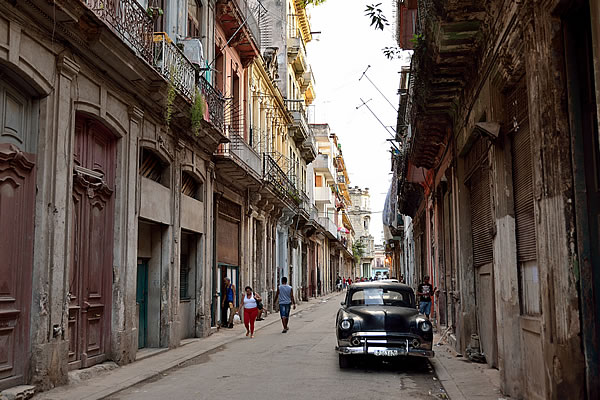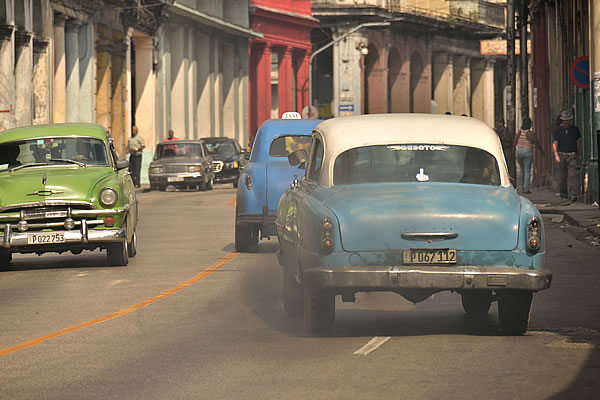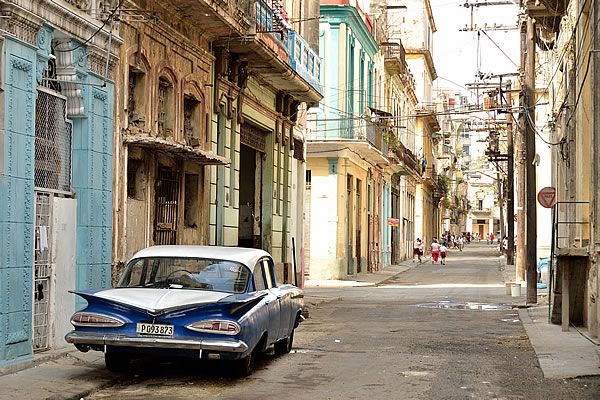English | Dutch |
|
| La Habana | |
Viñales (Cuba), January 20th 2015
|
|
| |
|
Every traveller knows the feeling; cities that have some kind of an attraction. Why this is, is difficult to explain. It can be the name, the history, the country in where the city is located, or just an unexplainable feeling. These are cities you really want to visit. We also have such a list of cities. Destinations on our list include among others: Beirut, Vladivostok, Timbuktu, Rio de Janeiro, Ulan Bataar and Manila. Fortunately, we were lucky to visit already some of these places. And now, we had the opportunity to visit another long wished destination: the capital city of Cuba: Havana. Or La Habana as the Cubans call it. The ‘why’ of Havana is also difficult to explain. It certainly has to do with the fact that it is the capital of a country that has such a turbulent recent history. Havana was difficult to visit as a result of the 1959 socialist/communist revolution led by revolutionaries Fidel Castro and Che Guevara. After the revolution, Cuba invested heavily in good relations with the Soviet Union. And this is something the US didn’t like. With the ‘new’ Cuba, it had the Soviets on its doorstep; Cuba is only 90 miles away from Florida! The tensions reached a peak in 1962, when the world was on the brink of a nuclear world war, when the US discovered that the Soviets had placed nuclear rockets on Cuban soil, of course directed on the US. Fortunately, the war was avoided but the relations between Cuba and the US (and also the rest of the free western world) remained ice cold. That also meant that Cuba was cut off from globalisation and the free market forces. Development fell back to almost zero and that means that still today you can witness this isolated period of the country. Poverty is high, buildings are in a very bad condition, stocks in shops are limited, and many cars on the Cuban streets date back from the 1940s and 1950s. |
|
 |
|
Havana, one of the world's most beautiful cities |
|
These are for us enough reasons to visit Cuba and of course its capital city. The timing became more and more important, because it seems that the relationship between the US and Cuba is improving. And a better relationship between these two countries will definitely mean that Cuba’s development will benefit from it. So we thought that if we want to see the present Cuba, we had to go now. We arrived in Havana by Hershey train, an electrical railway line developed in 1921 by US chocolate Czar Hersey. And the line is still as it was in the 1920s. The same line and the same carriages. The train took us from the city of Matanzas to a small village called Casablanca, on the other side of the Bay of Havana, just 10 minutes by ferry from the centre of Havana. We found a room in an apartment of a local family (Casa Particular) in the heart of the old town, a couple of minutes’ walk from Plaza Vieja, one of the four old squares around which the old part of Havana is built. This was our base to explore the city. Roughly spoken, Havana consists of three parts. The historical part is called Habana Vieja and this is the part that attracts the visitors. The second part is the commercial heart of town and is called Habana Centro. The richer and residential part of the city, more to the west, is called Vedado, the place where the richer Havana residents live. This is also the part where the more expensive restaurants, hotels and nightclubs are located. The main part of the historic part of Havana is nowadays restored and attracting 90% of the visitors, including visitors that arrive on a Cruise Ship as part of their Caribbean Cruise. Many historic buildings in Habana Vieja look very nice and it is easy to understand why it attracts an increasing amount to tourists. However, the negative consequence is that this part of town lost parts of its charm. Many streets and plazas are stripped from its Cuban life and serve today as tourist facilities. Most buildings are occupied by hotels, restaurants, overpriced cafés and souvenir shops. Only at the edges of the old town you will still find streets where the Cubans live. And this will probably also change when the government starts restoring this part of town. | |
 |
|
A typical street in La Habana Centro |
|
We definitely like Habana Centro (commercial centre) the most. This part of town is not restored (yet) and this is the place where the normal people live. The bigger, blue smoke covered streets, serve as traffic arteries where also the shops are located, while the narrower side streets serve as residential streets. These streets are a feats for the eye. Crumbling buildings, old American cars, small mobile fruit stalls, bicycle taxis and families whose social life happens in the street, is the microcosms of Cuban life. You need all your senses. The smell of fresh bread from a 1950s bakery is replaced a couple of metres further by stench from a hole in the sidewalk. And the voice of a yoghurt seller, who sells his products from a small box on the back of his bicycle, is just nearly hard enough to OVERSTEM the noisy that comes from the sound box of a cd-seller who sells his music out of his living room. You need 100% of your eye sight to enjoy all this beauty, but remember to keep your eyes also on the street; not only to avoid the dog shit, but also to prevent breaking your neck in one of the huge holes in the sidewalk. Habana Centro is also the part of town to avoid the expensive tourist restaurants of Habana Vieja. In this part of town you can still eat for a Euro per person. For most visitors, the Vedado part of town is probably the least interesting area. But still it has some interesting sights. There are a couple of hotels that played an important role in the recent history of Havana. There is for example the former Hilton Hotel (now the Habana Libre Hotel), which was nationalised by Fidel Castro, just nine months after its opening in 1959. Castro used a luxurious suite on the 24th floor of this hotel during the first months after the revolution, as his office to rule the country. You can see some old pictures from 1959 in the lobby on where heavily armed revolutionaries take a break in the lobby of the hotel just after they conquered Havana. Another hotel in the area is the Hotel Nacional, which was in 1946 the scene of the biggest-ever gathering of the North American mafia. They met here while enjoying a concert of Frank Sinatra. So, there are enough reason to visit also this part of town if you have time. But wherever you go, or whatever you do in Havana, it will definitely be a success! |
|
 |
|
Life music in one of Cuba's many bars |
|
 |
|
Avenida Salvador Allende |
|
 |
|
Havana: not a city if you have serious lung problems |
|
 |
|
Yes, also this is 2015 in Havana |
|
 |
|
Still reality in Havana: a taxi stand for 'collectivo taxis' |
|